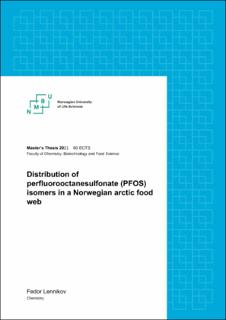| dc.contributor.advisor | Kallenborn, Roland | |
| dc.contributor.advisor | Ali, Aasim Musa | |
| dc.contributor.advisor | Havranek, Ivo | |
| dc.contributor.author | Lennikov, Fedor | |
| dc.date.accessioned | 2022-02-11T15:05:27Z | |
| dc.date.available | 2022-02-11T15:05:27Z | |
| dc.date.issued | 2021 | |
| dc.identifier.uri | https://hdl.handle.net/11250/2978543 | |
| dc.description.abstract | Perfluorooctanesulfonate (PFOS) is a global synthetic fluoroorganic compound and one of the most abundant per- and polyfluorinated alkylated substances (PFAS) in the arctic environment. PFAS are ubiquitously dispersed throughout the planet’s aquatic environments, soils and wildlife. Their environmental persistence, tendency to bioaccumulate and biomagnify in food webs coupled with negative health effects at elevated levels has resulted in them being commonly described as persistent organic pollutants. Although PFOS and other PFAS compounds have been subject to increasing scientific interest in the decades following their discovery, much remains unknown and uncertain in regards to their global and local transport mechanisms as well as their potential as environmental toxins.
The objective of this study was to develop and validate an analytical method for the separation and determination of the individual PFOS isomers commonly found in environmental and technical samples, and attempt to quantitate them in biota samples from Svalbard, Norway. Collected samples from neighbouring levels of the food web at two different locations in the vicinity of Longyearbyen were analysed for the purpose of gaining insight into the levels of the individual PFOS-isomers, and changes happening to the isomer profile from one trophic level to the next.
A new high performance liquid chromatography mass spectrometry (HPLC-MS/MS) analytical method was designed by combining elements from other published studies. The method was used to separate four groups of PFOS isomers from a mixture and was applied to quantitate PFOS isomers in the biota samples.
It was found that the total PFOS concentrations and the relative concentrations of L-PFOS in the biota samples increased with increasing trophic levels, in agreement with previous reports on the isomer’s greater bioaccumulation tendency. Fish liver samples from a reference station without any known nearby local PFOS pollution sources were discovered to have higher total PFOS levels than fish liver samples from a station near a decommissioned fire-fighting station. However, a small sample size and uncertainty with regards to the quantitation made it hard to interpret the findings, as PFOS isomers at lower trophic levels were not detected due to insufficient sensitivity. | en_US |
| dc.description.abstract | Perfluoroktansulfonat (PFOS) er en syntetisk fluoroorganisk forbindelse og en av de mest utbredte per- og polyfluorinerte alkylerte stoffene (PFAS) i arktiske miljøer. PFAS er svært utbredt og er spredt over hele verdens akvatiske miljøer, jord og dyreliv. Deres persistente natur, tendens til å bioakkumulere og magnifisere I næringskjeder, samt deres negative helseeffekter ved forhøyede nivåer har gjort at de regnes som persistente organiske forurensningsstoffer. Selv om PFOS og andre PFAS forbindelser har vært gjenstand fot økende vitenskapelig interesse in tiårene etter deres oppdagelse, er det fortsatt mye som ikke er kjent når det kommer til deres globale og lokale transportmekanismer og deres potensiale som miljøgifter.
Formålet med denne studien var å utvikle og validere en analytisk metode til separasjon og bestemmelse and de individuelle PFOS isomerene tilstede i miljøprøver og i teknisk produkt, og forsøke å kvantifisere disse i biota-prøver fra Svalbard, Norge. Sampleprøver fra nærliggende trofiske nivåer i næringskjeden fra to ulike lokasjoner i området rundt Longyearbyen ble analysert i et forsøk på å skaffe seg innsikt i mengdene av de individuelle PFOS-isomerene, og hvordan isomerprofilen forandrer seg fra ett trofisk nivå til det neste.
En ny analytisk HPLC-MS/MS metode ble utviklet ved å kombinere elementer fra andre publiserte studier. Metoden ble brukt til å separere fire grupper PFOS isomerer fra en blanding og ble brukt til å separere fire grupper PFOS-isomerer fra en blanding og ble så benyttet til å kvantifisere isomerer i biotaprøvene.
Det ble påvist at den totale PFOS konsentrasjonen og de relative L-PFOS konsentrasjonen i biotaprøvene økte høyere opp i næringskjeden, i samsvar med tidligere rapporten om isomerens større bioakkumuleringsegenskaper. Fikseleverprøver fra en referansestasjon uten kjente nærliggende PFOS utslippskilder ble funnet å ha høyere total-PFOS konsentrasjoner enn fiskeleverprøver fra en stasjon nær en nedlagt brannøvelsesstasjon. Det lave prøveantallet og usikkerhet tilknyttet kvantifiseringen gjorde det vanskelig å tolke funnene, siden PFOS isomerer ikke ble kvantifisert ved lavere trofiske nivåer på grunn av utilstrekkelig sensitivitet. | en_US |
| dc.language.iso | eng | en_US |
| dc.publisher | Norwegian University of Life Sciences, Ås | en_US |
| dc.rights | Attribution-NonCommercial-NoDerivatives 4.0 Internasjonal | * |
| dc.rights.uri | http://creativecommons.org/licenses/by-nc-nd/4.0/deed.no | * |
| dc.title | Distribution of perfluorooctanesulfonate (PFOS) isomers in a Norwegian arctic food web | en_US |
| dc.type | Master thesis | en_US |
| dc.description.localcode | M-KJEMI | en_US |

